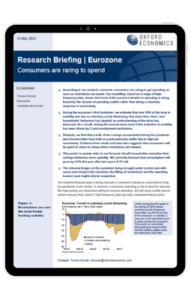Eurozone | Consumers are raring to spend

According to our analysis, eurozone consumers are raring to get spending as soon as restrictions are eased. Our modelling, based on a range of high-frequency data, shows that most of the current restraint on spending is being forced by the closure of spending outlets rather than being a voluntary response to uncertainty.
What you will learn :
- Since the eurozone’s first lockdown, firms’ and households’ behaviour has adapted as understanding of the virus has improved. As a result, during the second wave most of the reduction in mobility has been driven by Covid-containment restrictions.
- We find that a bulk of the savings accumulated during the pandemic were forced rather than built as a precautionary buffer due to high job uncertainty.
- Evidence from credit card data also suggests that consumers will be quick to return to shops when restrictions are relaxed.
Tags:
Related Services

Post
Nowcast shows wage growth slowing sharply
Our sentiment data, developed with Penta, suggests that UK private sector wage growth slowed sharply in March and early-April. If official data mirrors our sentiment indicator, it should keep the Monetary Policy Committee on track to cut interest rates in the summer.
Find Out More
Post
The euro and depreciation – shake, shake it off
Our new forecast assumes a slower euro appreciation against the dollar over the coming years than we previously anticipated. Relative productivity, terms of trade, and the current account will likely be less supportive of the euro than we thought. In addition, a stronger stock market than initially envisaged will attract more financial flows into the US than we had expected.
Find Out More